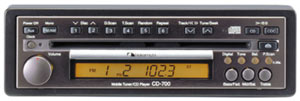 |
 |
Nakamichi CD700 www.nakamichi.com |
|||
| Nakamichiís CD700 forgoes bells and whistles for pure style and elegance. |
Price & Contact: $1750,
310-538-8150; http://www.nakamichi.com/ | |||
| by Brian Smith | ||||
| Here we have Nakamichiís offering in the ďopen
classĒ head unit category. A single-DIN CD/Tuner with CD changer control
that features 5-volt preamp outputs, subwoofer outputs, SPDIF digital
output, auxiliary inputs, and 24-bit DACs. The main focus of the CD700
seems to be playing single CDs in a highly accurate and user-friendly
fashion. The unit does not feature a detachable faceplate, internal
amplification, or even a boatload of DSP. Iím likiní this already...
Performance While in most technical categories the CD700 is among the best, it also possesses the highest output impedance weíve seen in quite a while. High output impedances can degrade the deckís ability to drive a signal free of radiated noise to your amplifier. Not exactly a desirable trait, but it certainly doesnít guarantee that youíll experience noise problems. Many factors contribute to noise immunity, so grab some good UTP signal cables and make the most of those 5.2-volt outputs. User Evaluation As you may have noticed in the specs, the CD700 has about .3 dB of channel error. Not a lot, but perhaps more than one would expect in a unit in this price range. However, because this unit has analog controls, that error can be trimmed to a few thousandths of a dB in about the time that it takes you to read this sentence. Try that trick with the average digi-knob and youíll only succeed in taking five times as long to get frustrated as hell. Then thereís that silky smooth volume control. The largest, easiest to reach control on the whole unit has but a single function ó to turn the volume up or down. Yessssss. This is how it should be done. Although itís simply a matter of taste, I should also mention that the CD700 doesnít light up your dashboard like some mutant freak Christmas tree; itís stealth via classiness you might say. Donít get me wrong; this thingís not ergonomically perfect. Your installer is probably going to gripe because he has to find somewhere to stash that external DC-to-DC converter. The buttons could always be larger and...well...damn, those pop-out tone control knobs are dead sexy!! Iím sure there are those who would disagree, but if this thing were to start an analog knob Ďtrendí in the head unit market, some of us would be delighted. |
 |
  |
